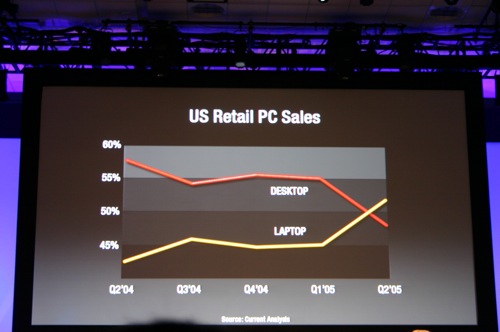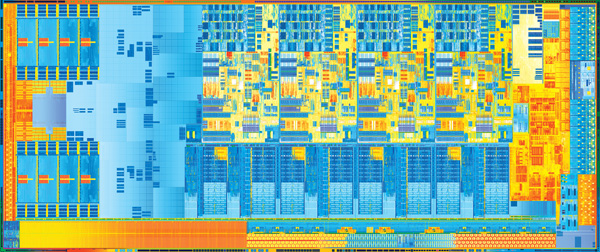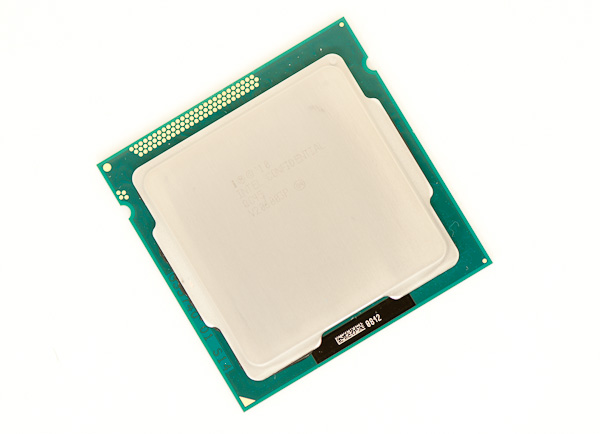The Intel Ivy Bridge (Core i7 3770K) Review
by Anand Lal Shimpi & Ryan Smith on April 23, 2012 12:03 PM EST- Posted in
- CPUs
- Intel
- Ivy Bridge
The times, they are changing. In fact, the times have already changed, we're just waiting for the results. I remember the first time Intel brought me into a hotel room to show me their answer to AMD's Athlon 64 FX—the Pentium 4 Extreme Edition. Back then the desktop race was hotly contested. Pushing the absolute limits of what could be done without a concern for power consumption was the name of the game. In the mid-2000s, the notebook started to take over. Just like the famous day when Apple announced that it was no longer a manufacturer of personal computers but a manufacturer of mobile devices, Intel came to a similar realization years prior when these slides were first shown at an IDF in 2005:
IDF 2005
IDF 2005
Intel is preparing for another major transition, similar to the one it brought to light seven years ago. The move will once again be motivated by mobility, and the transition will be away from the giant CPUs that currently power high-end desktops and notebooks to lower power, more integrated SoCs that find their way into tablets and smartphones. Intel won't leave the high-end market behind, but the trend towards mobility didn't stop with notebooks.
The fact of the matter is that everything Charlie has said on the big H is correct. Haswell will be a significant step forward in graphics performance over Ivy Bridge, and will likely mark Intel's biggest generational leap in GPU technology of all time. Internally Haswell is viewed as the solution to the ARM problem. Build a chip that can deliver extremely low idle power, to the point where you can't tell the difference between an ARM tablet running in standby and one with a Haswell inside. At the same time, give it the performance we've come to expect from Intel. Haswell is the future, and this is the bridge to take us there.
In our Ivy Bridge preview I applauded Intel for executing so well over the past few years. By limiting major architectural shifts to known process technologies, and keeping design simple when transitioning to a new manufacturing process, Intel took what once was a five year design cycle for microprocessor architectures and condensed it into two. Sure the nature of the changes every 2 years was simpler than what we used to see every 5, but like most things in life—smaller but frequent progress often works better than putting big changes off for a long time.
It's Intel's tick-tock philosophy that kept it from having a Bulldozer, and the lack of such structure that left AMD in the situation it is today (on the CPU side at least). Ironically what we saw happen between AMD and Intel over the past ten years is really just a matter of the same mistake being made by both companies, just at different times. Intel's complacency and lack of an aggressive execution model led to AMD's ability to outshine it in the late K7/K8 days. AMD's similar lack of an execution model and executive complacency allowed the tides to turn once more.
Ivy Bridge is a tick+, as we've already established. Intel took a design risk and went for greater performance all while transitioning to the most significant process technology it has ever seen. The end result is a reasonable increase in CPU performance (for a tick), a big step in GPU performance, and a decrease in power consumption.
Today is the day that Ivy Bridge gets official. Its name truly embodies its purpose. While Sandy Bridge was a bridge to a new architecture, Ivy connects a different set of things. It's a bridge to 22nm, warming the seat before Haswell arrives. It's a bridge to a new world of notebooks that are significantly thinner and more power efficient than what we have today. It's a means to the next chapter in the evolution of the PC.
Let's get to it.
Additional Reading
Intel's Ivy Bridge Architecture Exposed
Mobile Ivy Bridge Review
Undervolting & Overclocking on Ivy Bridge
Intel's Ivy Bridge: An HTPC Perspective




















173 Comments
View All Comments
ijozic - Thursday, April 26, 2012 - link
Maybe because people who prefer to have the IPS screen would also like to have support for graphics switching to have a nice battery life while not doing anything GPU intensive. This was the one thing I expected from Ivy Bridge upgrade and NADA.uibo - Monday, April 23, 2012 - link
Does anyone know if the 24Hz issue has been resolved?uibo - Monday, April 23, 2012 - link
nevermind just saw the htpc perspective reviewanirudhs - Monday, April 23, 2012 - link
I didn't notice that issue. 23.976*1000 = 23976 frames, 24 * 1000 = 24000 frames, in 16 mins 40 secs. So that's about one second of mismatch for every 1000 seconds. I could not notice this discrepancy while playing a Blu Ray on my PC. Could you?Old_Fogie_Late_Bloomer - Monday, April 23, 2012 - link
Okay, well, I'm pretty sure that you would notice two seconds of discrepancy between audio and video after half an hour of viewing, or four seconds after an hour, or eight seconds by the end of a two-hour movie.However, the issue is actually more like having a duplicated frame every 40 seconds or so, causing a visible stutter, which seems like it would be really obnoxious if you started seeing it. I don't use the on-board SB video, so I can't speak to it, but clearly it is an issue for many people.
JarredWalton - Monday, April 23, 2012 - link
I watch Hulu and Netflix streams on a regular basis. They do far more than "stutter" one frame out of every 960. And yet, I'm fine with their quality and so our millions of other viewers. I think the crowd that really gets irritated by the 23.976 FPS problems is diminishingly small. Losing A/V sync would be a horrible problem, but AFAIK that's not what happens so really it's just a little 0.04 second "hitch" every 40 seconds.Old_Fogie_Late_Bloomer - Monday, April 23, 2012 - link
Well, I can certainly appreciate that argument; I don't really use either of those services, but I know from experience they can be glitchy. On the other hand, if I'm watching a DVD (or <ahem> some other video file <ahem>) and it skips even a little bit, I know that I will notice it and usually it drives me nuts.I'm not saying that it's a good (or, for that matter, bad) thing that I react that way, and I know that most people would think that I was being overly sensitive (which is cool, I guess, but people ARE different from one another). The point is, if the movie stutters every 40 seconds, there are definitely people who will notice. They will especially notice if everything else about the viewing experience is great. And I think it's understandable if they are disappointed at a not insignificant flaw in what is otherwise a good product.
Now, if my math is right, it sounds like they've really got the problem down to once every six-and-a-half minutes, rather than every 40 seconds. You know, for me, I could probably live with that in an HTPC. But I certainly wouldn't presume to speak for everyone.
anirudhs - Tuesday, April 24, 2012 - link
I will get a discrete GPU and then do a comparison.anirudhs - Monday, April 23, 2012 - link
a discrete GPU! I could use a bump in transcoding performance for my ever-growing library of Blu-Rays.chizow - Monday, April 23, 2012 - link
Looks like my concerns a few years ago with Intel's decision to go on-package and eventually on-die GPU were well warranted.It seems as if Intel will be focusing much of the benefits from smaller process nodes toward improving GPU performance rather than CPU performance with that additional transistor budget and power saving.
I guess we will have to wait for IVB-E before we get a real significant jump in performance in the CPU segment, but I'm really not that optimistic at this point.